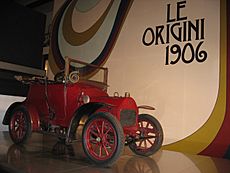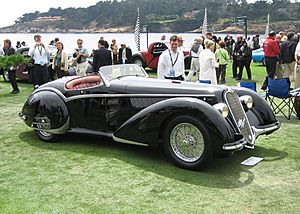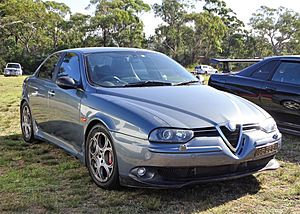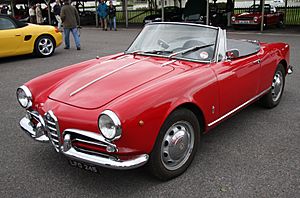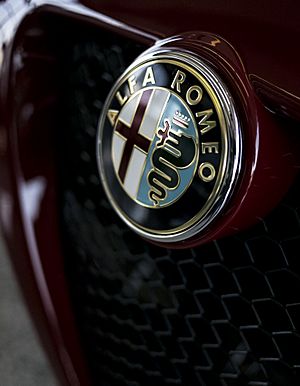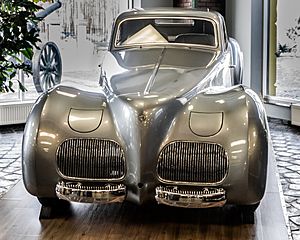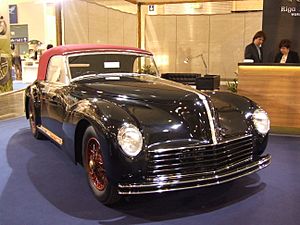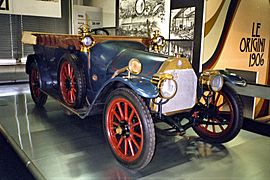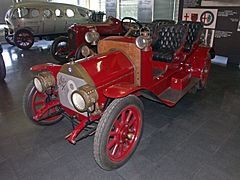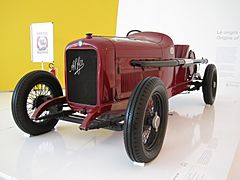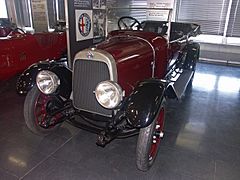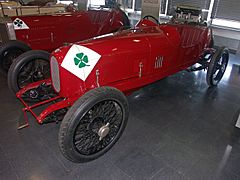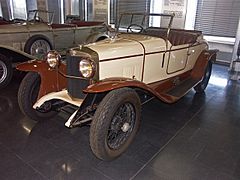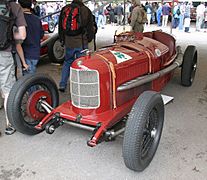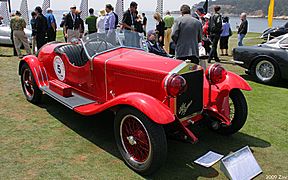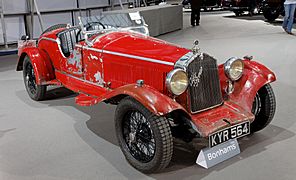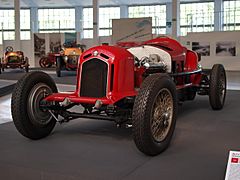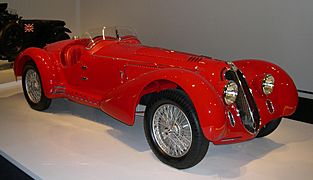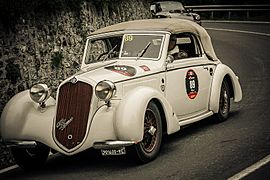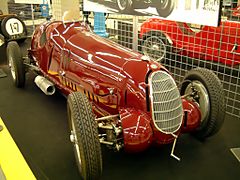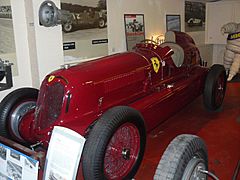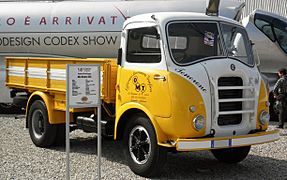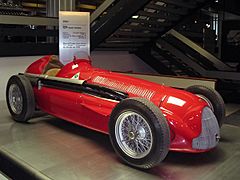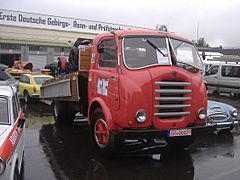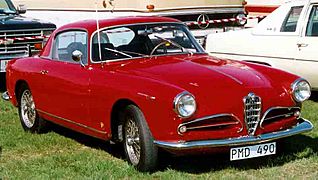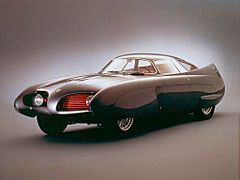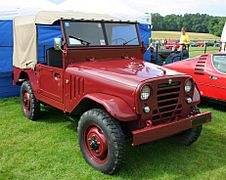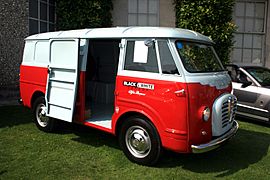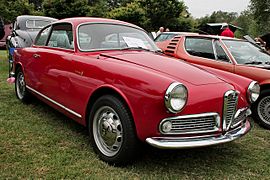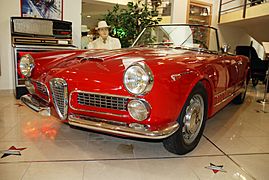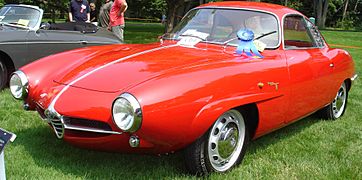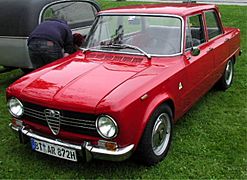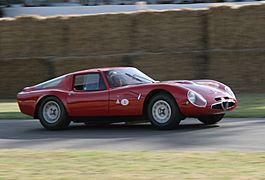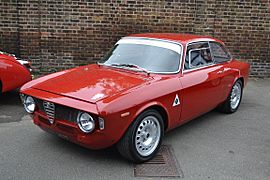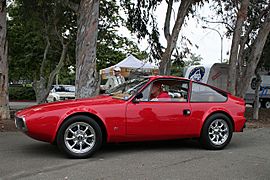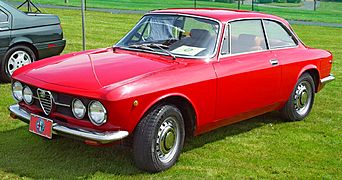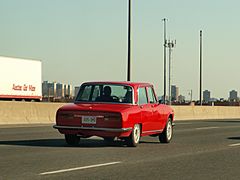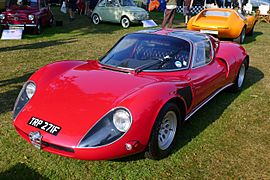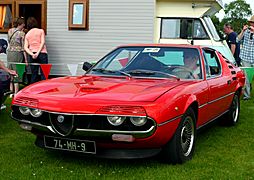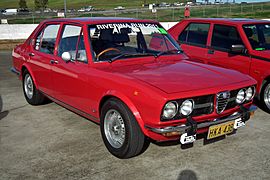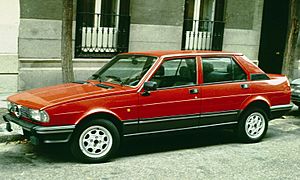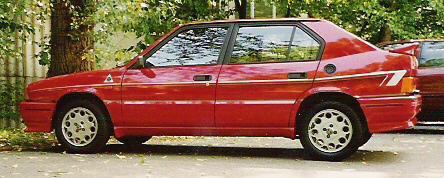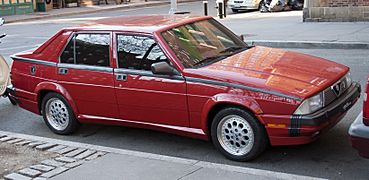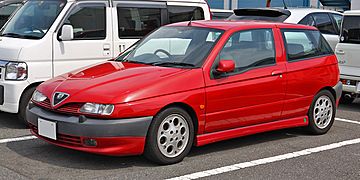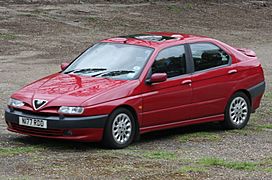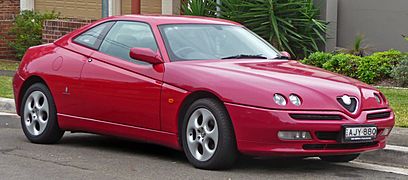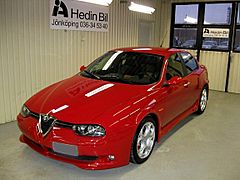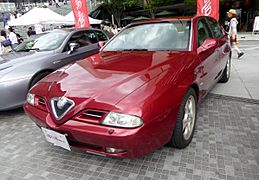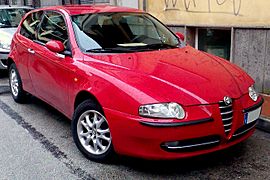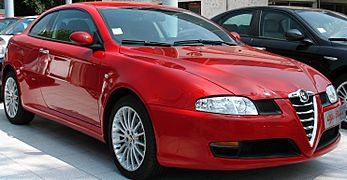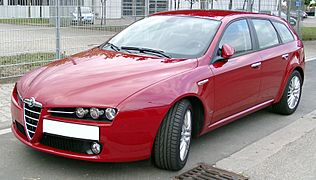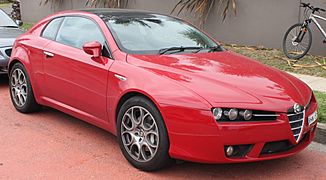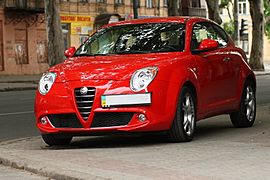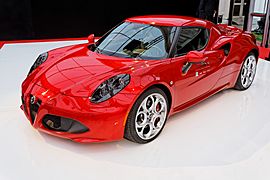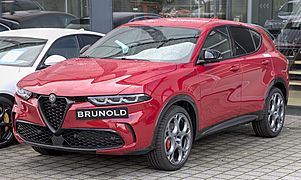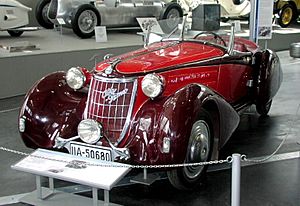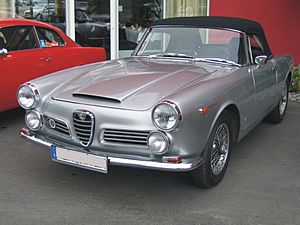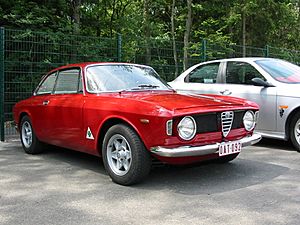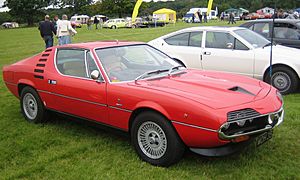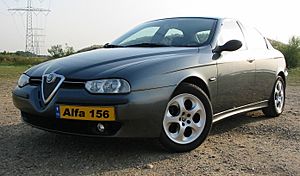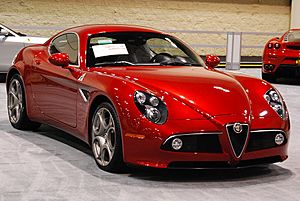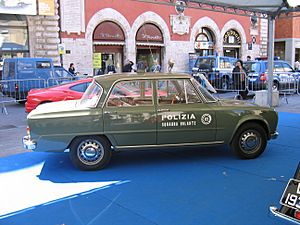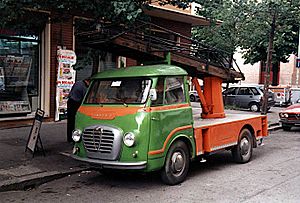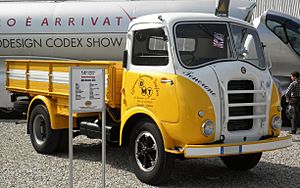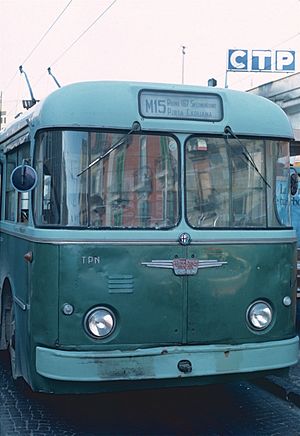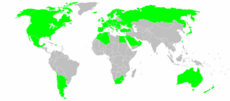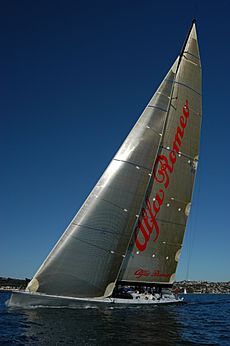Alfa Romeo facts for kids
 |
|
| Subsidiary | |
| Industry | Automotive |
| Founded | 24 June 1910 (as A.L.F.A.) Milan, Lombardy, Italy |
| Founders |
|
| Headquarters |
,
Italy
|
|
Area served
|
Worldwide |
|
Key people
|
Jean-Philippe Imparato (CEO) |
| Products | Luxury cars |
| Brands | Quadrifoglio |
|
Production output
|
44,115 units (2021) |
| Owner | Stellantis |
| Parent | Stellantis Italy |
Alfa Romeo Automobiles S.p.A. is a famous Italian company that makes luxury cars. It's part of a bigger company called Stellantis. Alfa Romeo started on June 24, 1910, in Milan, Italy.
The name "Alfa" comes from its first name, "Anonima Lombarda Fabbrica Automobili." "Anonima" means "anonymous," which was a type of company at the time. To start making cars, the company bought a factory building in Milan from another car company, Darracq. Alfa Romeo is well-known for making sporty cars and has been involved in car racing since 1911.
The very first car made by the company was the 1910 24 HP, designed by Giuseppe Merosi. Alfa Romeo quickly got into motor racing. Drivers Franchini and Ronzoni raced in the 1911 Targa Florio with two 24-hp models. In 1915, a businessman named Nicola Romeo took over. He changed the factory to make military equipment for the war effort. In 1920, the company's name officially became Alfa Romeo. The Torpedo 20–30 HP was the first car to have this new name.
Alfa Romeo has had great success in many car races, including Grand Prix motor racing, Formula One, and sportscar racing. They have raced both as a team that builds cars and as a supplier of engines. The first racing car was made in 1913. Alfa Romeo won the first world championship for Grand Prix cars in 1925. These wins made the brand seem very sporty. Even Enzo Ferrari started his famous Scuderia Ferrari racing team in 1929 as an Alfa Romeo racing team, before he started making his own cars.
History of Alfa Romeo Cars
How Alfa Romeo Got Its Name
The company's name is a mix of its first name, "A.L.F.A." (which stands for "Anonima Lombarda Fabbrica Automobili"), and the last name of Nicola Romeo. He was the businessman who took control of the company in 1915.
Starting Out and Early Years
The first factory building for A.L.F.A. used to belong to an Italian company called Società Anonima Italiana Darracq (SAID). This company was started in 1906 by a French car company, Darracq, with some Italian investors. One of these investors, Ugo Stella, became the chairman in 1909. The Darracq company was not selling many cars and was closing down. So, Ugo Stella and other Italian investors started a new company called A.L.F.A. They bought the Darracq factory and its equipment.
The first car A.L.F.A. made was the 1910 24 HP. It was designed by Giuseppe Merosi, who was hired to create cars better suited for the Italian market. Merosi went on to design more powerful cars like the 40–60 HP. A.L.F.A. quickly started racing. Drivers Franchini and Ronzoni competed in the 1911 Targa Florio with two 24-hp models. In 1914, they even designed an advanced Grand Prix racing car called the GP1914. However, the start of World War I stopped car production at A.L.F.A. for three years.
In August 1915, Nicola Romeo took over the company. He changed the factory to make military supplies for the war, like ammunition and aircraft engines. After the war, Romeo used his profits to buy other factories that made trains and railway parts.
Car production started again in 1919. This was because parts for 105 cars were still at the factory from 1915. In 1920, the company's name officially changed to Alfa Romeo. The Torpedo 20–30 HP was the first car to have this new name. Their first big win came in 1920 when Giuseppe Campari won a race at Mugello. Enzo Ferrari also got second place in the Targa Florio. Giuseppe Merosi stayed as the main designer. The company kept making good road cars and successful race cars.
In 1923, Vittorio Jano joined Alfa Romeo as the chief designer. He was convinced to join by a young Alfa racing driver, Enzo Ferrari. Jano's first car for Alfa Romeo was the P2 Grand Prix car. This car helped Alfa Romeo win the first world championship for Grand Prix cars in 1925. For road cars, Jano designed strong and reliable engines.
Enzo Ferrari was a better team manager than a driver. When the factory racing team became private, it was named Scuderia Ferrari. Later, Ferrari left Alfa Romeo to build his own cars. Tazio Nuvolari often drove for Alfa Romeo, winning many races before World War II.
In 1928, Nicola Romeo left the company. In 1933, the Italian government helped save Alfa Romeo. It became a national symbol for Italy. During this time, Alfa Romeo built special cars for rich people. These cars often had custom bodies made by famous designers like Carrozzeria Touring or Pininfarina. A great example from this time was the Alfa Romeo 2900B Type 35 race cars.
The Alfa factory was bombed during World War II. It had a hard time making money after the war. The company stopped making expensive luxury cars. Instead, they started making smaller cars for more people. This began in 1954 with the Giulietta series. These cars included sedans, coupes, and open-top two-seaters. All of them used the Alfa Romeo overhead Twin Cam four-cylinder engine. This engine was made until 1995.
When I see an an Alfa Romeo go by, I tip my hat.
– Henry Ford talking with Ugo Gobbato in 1939
After the War
After World War II, car racing started again. Alfa Romeo cars were very strong in Grand Prix races. The new Formula One racing series was perfect for Alfa Romeo's Tipo 158 Alfetta. Giuseppe Farina won the first Formula One World Championship in 1950 in the 158. Juan Manuel Fangio won Alfa's second championship in 1951.
In the 1950s, Alfa Romeo tried to make a small, front-wheel-drive car called "Project 13–61." They tried again later with the Tipo 103. This car looked like a smaller version of the popular Alfa Romeo Giulia. However, because Italy had money problems after the war, the Tipo 103 was never made. If it had been produced, it would have been one of the first modern front-wheel-drive compact cars, even before the Mini.
In the 1960s, Alfa Romeo focused on motorsports using cars based on their regular models. This included the GTA. It had an aluminum body and a powerful engine. The GTA won the first Sports Car Club of America's Trans-Am championship in 1966. In the 1970s, Alfa Romeo focused on prototype sports car racing with the Tipo 33. This car won the World Championship for Makes in 1975 and the World Championship for Sports Cars in 1977.
Since Alfa Romeo was controlled by the Italian government, it was sometimes affected by political decisions. To help develop southern Italy, a new factory was built in Pomigliano d'Arco to make a new compact car called the Alfa Sud (Alfa South). However, this factory had many problems, including workers who were not trained for car manufacturing.
By the 1970s, Alfa Romeo was having money problems again. The company was not making enough cars, and there were many worker strikes. The cars were also getting old, and Italy had high inflation. The government tried different ways to help Alfa Romeo. By 1986, the government company that owned Alfa Romeo was losing a lot of money. Alfa Romeo had not made a profit for 13 years. So, Alfa Romeo was put up for sale.
Fiat Takes Over Alfa Romeo
Fiat first offered to start a joint company with Alfa Romeo. However, Ford also made an offer to buy part of Alfa Romeo. Fiat then decided to buy all of Alfa Romeo and promised to keep Italian workers employed. Ford was not willing to make the same promise. In 1986, the deal was made. Alfa Romeo joined Fiat's group, along with its old rival, Lancia.
Cars made from the 1990s onwards combined Alfa's classic style and sporty feel with the benefits of being part of a larger company. These cars included a "GTA" version of the 147 hatchback, the Giugiaro-designed Brera, and a high-performance car called the 8C Competizione.
In 2005, Maserati was bought back by Fiat. Fiat then created a sports and luxury car division with Maserati and Alfa Romeo. They planned to share engines, car platforms, and possibly dealerships.
In 2007, Fiat Auto S.p.A. was reorganized. Four new car companies were created: Fiat Automobiles S.p.A., Alfa Romeo Automobiles S.p.A., Lancia Automobiles S.p.A., and Fiat Light Commercial Vehicles S.p.A. These companies were fully owned by Fiat Group Automobiles S.p.A.
On June 24, 2010, Alfa Romeo celebrated 100 years since it was founded.
Recent Changes
Alfa Romeo has faced challenges with falling sales. In 2010, they sold about 112,000 cars. This was much lower than the target of 300,000 cars. In 2011, they aimed for 170,000 units but sold 130,000. Their goal for 2014 was 500,000 units. In 2017, Alfa Romeo increased production by 62 percent, making 150,722 vehicles.
On January 16, 2021, Fiat Chrysler Automobiles and Groupe PSA merged to form Stellantis. Alfa Romeo became part of Stellantis Italy.
Despite falling sales, Alfa Romeo's CEO announced in 2021 that a new model would be launched every year from 2022 to 2026. The first of these was the Tonale. The company plans for all new models to be electric from 2027.
Returning to North America
Alfa Romeo cars were first brought to the United States by Max Hoffman in the mid-1950s. The Giulietta Spider was even created because Max Hoffman asked for an open-top version of the Giulietta. In 1961, Alfa Romeo started sending cars to the U.S. through its own dealerships.
In 1995, Alfa Romeo stopped selling cars in the United States. The last model sold there was the 164 sedan.
On May 5, 2006, Alfa Romeo announced its return to the U.S. market. Sales started again in October 2008 with the special 8C Competizione coupe. Fiat's U.S. company, Chrysler, imported these Alfa Romeo models. In 2014, the more affordable two-seater 4C coupe was launched. In 2015, Alfa Romeo showed off the new Giulia at the Los Angeles Auto Show. In February 2017, Chrysler promoted Alfa Romeo with three commercials during the Super Bowl LI.
Today, FCA US LLC imports the 4C, Giulia, and Stelvio to the U.S.
Design and Technology of Alfa Romeo Cars
Cool Technology Over the Years
Alfa Romeo has introduced many new technologies over the years. The company was often one of the first to use new ideas. Its famous double overhead cam engine was first used in the 1914 Grand Prix car. The first road car with such an engine, the 6C 1500 Sport, appeared in 1928.
Alfa Romeo tested one of the first electronic fuel injection systems in 1940. This system had six electric fuel injectors. Mechanical variable valve timing was first used in the Alfa Romeo Spider in 1980. This system helps the engine run better. All Alfa Romeo Spider models from 1983 onwards used electronic VVT.
The 105 series Giulia was a very advanced car. It used technologies like disc brakes on all wheels and had a very low drag coefficient (meaning it cut through the air easily). The Alfetta 2000 and GTV also had special features like balanced weight distribution and alloy wheels.
Newer inventions include using CAD (computer-aided design) to create the Alfa Romeo 164. This meant very little was made by hand. The 156 was the world's first passenger car to use a Common rail diesel engine. The Multiair system, which controls engine valves using hydraulics, was introduced in the MiTo in 2009. In 2016, the Alfa Romeo Giulia came with electric brakes.
How Alfa Romeo Cars Look
Many famous car design companies in Italy have created shapes for Alfa Romeo cars. These include:
- Bertone
- Giorgetto Giugiaro / Italdesign
- Pininfarina
- Zagato
- Centro Stile Alfa Romeo (Alfa Romeo's own design center)
Alfa Romeo's car designs have often been copied by other carmakers. Here are some examples:
- 1960s: Aerodynamics: The Giulia cars had a very low drag. Other car companies, like Toyota, tried to make cars with similar shapes.
- 1970s: Bumpers that blend in: To meet American safety rules, Alfa Romeo designed bumpers that looked like part of the car's body. The Alfa Romeo 75 in the 1980s was a great example. This idea was copied by many, especially in Germany and Japan.
- 1980s: The Alfa Romeo 164: This car was designed almost entirely using computers (CAD/CAM). Its style influenced many modern Alfa Romeos. Other car makers also started using design ideas from the 164, like relying more on on-board computers.
- 1990s: The "fake" coupe: The 156 and 147 were four-door cars that looked like two-door coupes. They had clear front door handles but hidden rear door handles. Honda and Mazda have used similar ideas.
- 2000s: The Brera and 159: These cars, designed by Giorgetto Giugiaro, showed that concept cars can become real road cars if designed with computer systems from the start.
Concept Cars
Alfa Romeo has made several amazing concept cars:
- 1950s – The B.A.T. cars
The Berlina Aerodinamica Tecnica (B.A.T.) cars were special prototypes. They were designed to see if very smooth, wind-tunnel tested shapes would make cars perform better. They also wanted to see if people would like how these cars looked. The B.A.T. 5, 7, and 9 were based on the Alfa 1900 Sprint. The later B.A.T. 11 was based on the 8C Competizione.
- 1960s and 1970s – Cars from the Tipo 33
The Tipo 33 racing car, with its powerful V8 engine, was used to create many different concept cars. Two of these even became cars that were sold to the public.
- Gandini/Bertone Carabo (1968) – This car showed ideas that would later be used in the famous Lamborghini Countach.
- Gandini/Bertone Montreal Concept (1967) – This car was shown at the 1967 Montreal Expo. It led to the production of the Alfa Romeo Montreal road car.
- 1980s-Today – Modern Ideas
Today, many Alfa Romeo concept cars often become real production cars. They are changed a bit to be safe and easy to make. The Zagato SZ, GTV, Spider, Brera, and 159 are good examples of this.
Alfa Romeo Logos
The Original Logo

Alfa Romeo's logo uses two symbols from its hometown, Milan. On the left is a red cross, from the Milan flag. On the right is the biscione, a large grass snake eating a child. This was the symbol of the House of Visconti, who ruled Milan in the 14th century.
A young artist named Romano Cattaneo from Alfa's design office created the logo in 1910.
How the Logo Started
In June 1910, the company became Anonima Lombarda Fabbrica Automobili (A.L.F.A.). They were getting ready to make their first car, the 24 HP. The company asked chief engineer Giuseppe Merosi to design a badge for the car. Merosi asked his team for ideas. Cattaneo was inspired by a coat of arms he saw on the gates of Castello Sforzesco. It had the biscione on it. Merosi liked the idea, and they made a sketch together. Cattaneo then did the final design.
The first badge was round and made of brass. It had the red cross of Milan on the left and a green biscione on a light blue background on the right. A blue ring surrounded it with "ALFA" at the top and "MILANO" at the bottom. Two figure-eight knots, symbols of the royal family, separated the words. In 1913, the lettering changed to white. In 1918, after Nicola Romeo bought the company, "ALFA" was changed to "ALFA-ROMEO."
In 1925, a silver laurel wreath was added around the badge. This was to celebrate the Alfa Romeo P2 winning the first World Manufacturers' Championship in 1925. This wreath was used until 1982.
Changes After the War
In 1946, after Italy became a republic, the royal knots were replaced with two curvy lines. The badge was also redesigned and made smaller. It was made of stamped steel with the traditional symbols in silver on a red background. In 1960, the badge changed from brass to plastic.
In the early 1970s, a new factory was built near Naples. When the Alfasud became the first Alfa Romeo car made outside Milan in 1972, the word "Milano," the curvy lines, and the hyphen between "Alfa" and "Romeo" were removed from the badge on all cars. The biscione and the font were also updated.
After a small update in 1982, which removed the wreath and changed chrome details to gold, this badge was used until 2015.
2015 Redesign
On June 24, 2015, Alfa Romeo's 105th anniversary, a new logo was shown. This happened at the Alfa Romeo Museum with the new Alfa Romeo Giulia. The new logo was designed by Robilant Associati.
The logo now uses three colors: green for the biscione, red for the cross, and dark blue for the ring. Other changes include a new font and a single silver background instead of the split white and light blue fields.
The Quadrifoglio Logo
Since 1923, the quadrifoglio logo (also called the 'cloverleaf') has been a symbol for Alfa Romeo racing cars. After World War II, it also started being used on the sportiest models of their road cars. The quadrifoglio is usually placed on the side of the car, near the front wheels. The logo is a green four-leaf clover inside a white triangle. There are two types: "Quadrifoglio Verde" (Green Cloverleaf) and "Quadrifoglio Oro" (Gold Cloverleaf).
Story of the Emblem

The quadrifoglio has been used on Alfa Romeo cars since the death of Ugo Sivocci in 1923. Sivocci was a driver for Alfa Romeo's racing team, Alfa Corse. He was known for having bad luck in races. To try and change his luck, before the Targa Florio race, he painted a white square with a green four-leaf clover on the front of his car. Sivocci won that race! The quadrifoglio then became a symbol for Alfa Romeo's racing cars.
A few months later, Sivocci was killed while testing a new car, the P1, at Monza. His P1 did not have the quadrifoglio on it. Since then, Alfa Romeo racing cars have had the quadrifoglio as a good luck charm. The white square was changed to a triangle to remember Ugo Sivocci.
How it's Used Today
The first road car to have the quadrifoglio was the 1963 Alfa Romeo Giulia TI Super. It was a version of the Giulia sedan made for racing but also sold to the public. It had green four-leaf clovers on its front sides, but without the triangle.
In the 1970s, "Quadrifoglio Verde" (Green Cloverleaf) became the name for the sportiest versions of each model, which had the most powerful engines. Many models, like the Alfasud and 75, had Quadrifoglio Verde versions.
Also in the 1970s and 1980s, golden four-leaf clover badges were used for the most luxurious and well-equipped Alfa Romeo cars. These were called "Quadrifoglio Oro" (Gold Cloverleaf).
Recently, the quadrifoglio was brought back on the 2007 Alfa Romeo 8C Competizione sports cars. With the current Alfa Romeo MiTo and Giulietta, Quadrifoglio Verde is again the name for the sportiest models. Green four-leaf clovers on the front sides are now a sign of high-performance Alfa Romeos.
Alfa Romeo's 2016 sports sedan, the new Giulia, was first launched in its Quadrifoglio version. This showed how important this historic emblem is.
Alfa Romeo in Motorsports
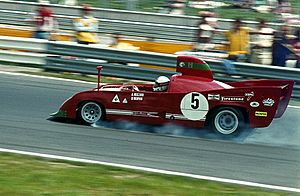
Alfa Romeo has been involved in car racing since 1911. They entered two 24 HP models in the Targa Florio race. Alfa Romeo won the first World Manufacturers' Championship in 1925. They also won the first AIACR European Championship in 1931. They had many wins in famous races like Targa Florio, Mille Miglia, and Le Mans.
Great success continued in Formula One. Alfa Romeo won the first World Formula One Championship in 1950 and the second in 1951. The company also won international championships in Prototypes, Touring, and Fast Touring categories in the 1960s and 1970s. Private drivers also entered some rally competitions and did well.
Alfa Romeo has raced both as a team that builds cars (like Alfa Corse and Autodelta) and as an engine supplier. Between 1933 and 1938, Alfa Romeo's factory racing team was managed by Enzo Ferrari's Scuderia Ferrari. Famous drivers like Tazio Nuvolari drove for them, winning the 1935 German Grand Prix.
Since 2018, Alfa Romeo has worked with the Sauber F1 Team. Since 2019, they have competed in Formula One as Alfa Romeo.
Alfa Romeo has also won 5 FIA European Formula 3 Championships and 5 FIA European Formula 3 Cups. They did this with help from their team Euroracing and Italian engine company Novamotor.
Where Alfa Romeo Cars Are Made
In the 1960s, the main Alfa Romeo factory moved from inside Milan to a very large area near Arese. The offices and main entrance were in Arese.
In the late 1960s, Alfa Romeo also built cars in South Africa. From 1972 to 1989, South Africa had the most Alfa Romeos on the road outside of Italy. The factory in Brits, South Africa, even built Daihatsu Charades for a few years. In late 1985, Alfa Romeo left the South African market and closed the plant.
In the 1990s, Alfa Romeo moved car production to other parts of Italy. The Pomigliano d’Arco plant made models like the 155, 145, and 146. The Arese plant made sports cars like the SZ and RZ, and the 164, Spider, and GTV. The 156 was launched in 1997 and was very successful. It was voted "Car of the Year" in 1998. In 2003, the Arese factory closed, keeping only some offices and the Alfa Romeo Historical Museum.
| Assembly plants by model | |||
|---|---|---|---|
| Plant | Owner | Location | Model(s) |
| Cassino – Piedimonte S. Germano | Alfa Romeo S.p.A. | Piedimonte San Germano | Giulia, Stelvio |
| Società Automobilistica Tecnologie Avanzate S.p.A. | Fiat Group | Melfi | Tonale |
Alfa Romeo Cars
| Alfa Romeos |
|---|
Current Alfa Romeo Models
| Giulia | Stelvio | Tonale | |
|---|---|---|---|
 |
 |
 |
- Alfa Romeo Giulia
The new Giulia was shown to the public on June 24, 2015. This was on the company's 105th anniversary. Sales were about 34,000 cars per year in 2018, but then dropped to 20,000 per year in 2019.
- Alfa Romeo Stelvio
The Stelvio was shown at the 2016 Los Angeles Auto Show. The Stelvio is Alfa Romeo's first SUV. It competes with cars like the Porsche Macan and BMW X3. It is currently Alfa's best-selling model, with less than 40,000 sold per year in 2019.
- Alfa Romeo Tonale
The Tonale is a compact SUV. It was introduced in March 2022. It is the first new model from Alfa Romeo in six years. It is also the first model launched under the Stellantis brand.
Historic Alfa Romeo Models
| Road cars | Racing cars | |
|---|---|---|
| 1910 |
1910–1920 24 HP |
1911 15 HP Corsa |
| 1920 |
1921–1922 20–30 HP |
1922 RL Super Sport |
| 1930 |
1931–1934 8C 2300 |
1931 Tipo A |
| 1940 |
1948 6C 2500 Competizione |
|
| 1950 |
1950–1958 1900 |
1951 159 |
| 1960 |
1962–1968 2600 1965–1977 GT Junior |
1960 Giulietta SZ |
| 1970 |
1970–1977 Montreal |
1972 33/4 |
| 1980 |
1983–1994 33 |
1982 182 |
| 1990 |
1992–1998 155 |
1992 155 GTA |
| 2000 |
2000–2010 147 |
2003 147 GTA Cup |
| 2010 |
2010–2020 Giulietta |
2015 TCR/WTCR/BTCC Giulietta QV |
Alfa Romeo for Police and Government
Since the 1960s, Alfa Romeo cars have been popular with the Italian police and Carabinieri (a part of the Italian armed forces that also does civilian policing). Cars like the "Giulia Super" and the 2600 Sprint GT were used. Police Alfa Romeos are often green/blue with white stripes and are called "Pantera" (Panther). Carabinieri Alfas are dark blue with white roofs and red stripes, called "Gazzella" (Gazelle). These names show the cars' aggressive look, speed, and agility.
Alfa Romeos are still chosen by the Carabinieri, highway police, and regular police. Here are some Alfa Romeo cars used by Italian police and government:
- Alfa Romeo AR51
- Alfa Romeo Giulia
- Alfa Romeo Alfetta
- Alfa Romeo Giulietta
- Alfa Romeo 33 (Police only)
- Alfa Romeo 75
- Alfa Romeo 164 (official vehicles)
- Alfa Romeo 155
- Alfa Romeo 156
- Alfa Romeo 166 (official vehicles)
- Alfa Romeo 159
- Alfa Romeo Giulia (Carabinieri, Police)
Since the 1960s, Italian Prime Ministers have often used Alfa Romeos as their official cars. The 164 and 166 models were especially used in recent decades.
Trucks and Light Commercial Vehicles
In 1930, Alfa Romeo started making light trucks. They also made heavy trucks based on other designs. During World War II, Alfa Romeo built trucks for the Italian and German armies. After the war, they continued making commercial vehicles.
They also worked with Fiat and Saviem to develop different light truck models.
Alfa Romeo stopped making heavy commercial vehicles in Italy in 1967. Heavy trucks continued to be built for a few years in Brazil by an Alfa Romeo company called FNM. The last Alfa Romeo vans were the AR6 and AR8, which were rebadged versions of other company's vans. The company also made trolleybuses for many cities around the world. Later, Alfa Romeo focused only on making passenger cars.
- LCVs (Light Commercial Vehicles)
- Alfa Romeo Romeo (1954–1958)
- Alfa Romeo Romeo 2 (until 1966)
- Alfa Romeo Romeo 3 (1966)
- Alfa Romeo A11/F11 (1954–1983)
- Alfa Romeo A12/F12
- AR8 (based on first generation Iveco Daily)
- AR6 (based on first generation Fiat Ducato)
- Alfa Romeo F20 (Saviem license)
- Trucks
- Alfa Romeo 50 "Biscione" (1931–1934)
- Alfa Romeo 85 / 110 (1934 – n/a)
- Alfa Romeo 350 (1935 – n/a)
- Alfa Romeo 430 (1942–1950)
- 450/455 (1947–1959)
- Alfa Romeo 500 (1937–1945)
- Alfa Romeo 800 (1940–1943)
- Alfa Romeo 900 (1947–1954)
- Alfa Romeo 950 (1954–1958)
- Alfa Romeo Mille (Alfa Romeo 1000) (1958–1964)
- Alfa Romeo A15 (Saviem license)
- Alfa Romeo A19 (Saviem license)
- Alfa Romeo A38 (Saviem license)
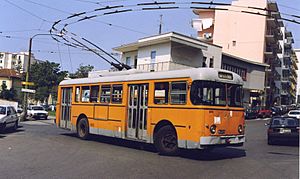
- Buses
- Alfa Romeo 40A
- Alfa Romeo 80A
- Alfa Romeo 85A
- Alfa Romeo 110A
- Alfa Romeo 140A (1950–1958)
- Alfa Romeo 150A (1958)
- Alfa Romeo 430A (1949–1953)
- Alfa Romeo 500A (1945–1948)
- Alfa Romeo 800A
- Alfa Romeo 900A (1953–1956)
- Alfa Romeo 902A (1957–1959)
- Alfa Romeo 950A
- Alfa Romeo Mille (bus) (Alfa Romeo 1000) (1960–1964)
- Trolleybuses
- Alfa Romeo 85AF (1936-1940)
- Alfa Romeo 110AF (1938)
- Alfa Romeo 140AF (1949)
- Alfa Romeo 800AF (1950–1954)
- Alfa Romeo 900AF (1955–1957)
- Alfa Romeo 911AF (1959–1960)
- Alfa Romeo Mille Aerfer (1960–1963)
- Alfa Romeo Mille AF (1959–1964)
Other Things Alfa Romeo Has Made
Even though Alfa Romeo is best known for cars, it has also made many other things. These include trucks, railway locomotives, tractors, buses, trams, compressors, generators, and even an electric cooker. They also made engines for boats and airplanes.
Aircraft Engines
An Alfa engine was first used in an airplane in 1910. In 1932, Alfa Romeo built its first real aircraft engine, the D2. In the 1930s, many planes used Alfa Romeo engines. During World War II, Alfa Romeo built various aircraft engines. The most famous was the RA.1000 RC 41-I Monsone, which was a licensed version of a German engine. This engine helped build powerful fighter planes for the Italian army.
After World War II, Alfa Romeo made engines for other companies like Fiat. In the 1960s, Alfa Romeo mostly focused on fixing and maintaining aircraft engines from other big companies. Alfa Romeo also built Italy's first turbine engine. Alfa Romeo's Avio division was sold in 1988.
Marine Engines
Alfa Romeo also made engines for boats. The first marine engine was made in 1929. For three years in a row (1937-1939), Alfa Romeo showed how good its marine engines were.
List of Aero-Engines
- Alfa Romeo D2
- Alfa Romeo 110
- Alfa Romeo 115
- Alfa Romeo 121
- Alfa Romeo 125
- Alfa Romeo 126
- Alfa Romeo 128
- Alfa Romeo 135
- Alfa Romeo Lynx
- Alfa Romeo Mercurius
- Alfa Romeo RA.1000
- Alfa Romeo RA-1050
- Alfa Romeo R.C.10
- Alfa Romeo R.C.34
- Alfa Romeo R.C.35
- Alfa Romeo AR.318
Marketing and Sponsorship
Over the years, Alfa Romeo has used different slogans to advertise its cars. Some examples are: "The family car that wins races" (1950s), "racing since 1911" (1960s), and "Mediocrity is a sin." More recent slogans include "Driven by Passion," "Cuore Sportivo" (Sporty Heart), "Beauty is not enough," and "Without heart we would be mere machines." Another well-known slogan is: "It's not a car, it's an Alfa Romeo."
Alfa Romeo sponsors many sporting events. They sponsor the Mille Miglia rally. They have also sponsored the SBK Superbike World Championship and Ducati Corse since 2007. They have been a sponsor of the Goodwood Festival of Speed for many years. In 2010, when Alfa Romeo celebrated its 100th anniversary, it was a featured brand there. The Alfa Romeo Giulietta has been used as the safety car in Superbike World Championship events since 2010. Alfa Romeo also sponsored the Eintracht Frankfurt football club from 2013 to 2016.
In 2002, the first Alfa Romeo super maxi yacht was launched. It won many races, including the 2002 Sydney to Hobart Yacht Race. Alfa Romeo II, launched in 2005, set a new speed record in the 2009 Transpac race. It won at least 140 races. In 2008, Alfa Romeo III was launched for competitive racing.
The BBC car show Top Gear often talks about how important it is for a car enthusiast to own an Alfa Romeo. They say, "You can't be a true petrolhead if you have never owned/or wanted to own an Alfa Romeo." The presenters, Jeremy Clarkson, Richard Hammond, and James May, often praise Alfas for their beauty and how they drive. They say that owners build a special relationship with the car, even if it has mechanical problems. Both Clarkson and May have owned Alfas before and said they regretted selling them the most.
As part of its return to the U.S., Alfa Romeo ran three commercials during Super Bowl LI. In February 2013, Alfa Romeo sponsored the University of St Andrews FS fashion show.
In 2021, Alfa Romeo announced Zhou Guanyu as China's first ever Formula One racing driver for the 2022 season. This was seen as a big step for the sport in a growing market.
See Also
 In Spanish: Alfa Romeo para niños
In Spanish: Alfa Romeo para niños
- Alfa Romeo Arese Plant
- Alfa Romeo Pomigliano d'Arco Plant
- Alfa Romeo Portello Plant
- Alfa Romeo Museum
- Circuito di Balocco
- Alfa Romeo in motorsport
- Category: Alfa Romeo engines
- Category: Alfa Romeo people


